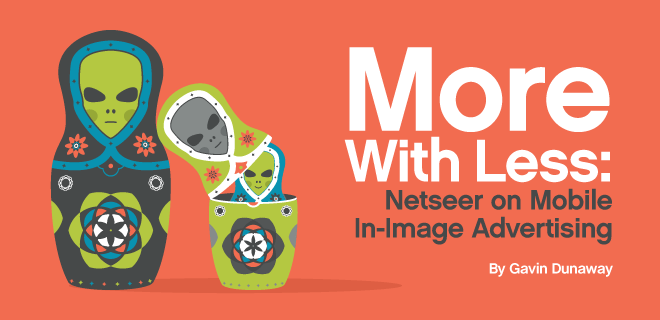
Look upon the pages of AdMonsters.com to see the woe mobile monetization has caused publishers. With 2016 likely marking the close of the mobile interstitial age, pubs are frantically searching for revenue opportunities. But prime ad inventory has been sitting, waiting to be discovered: images.
“We’re quickly becoming a mobile-first company in terms of revenue,” says Amir Bahkshaie, Head of Product for visual monetization specialist NetSeer. “On certain days this quarter we’re starting to see higher mobile revenue than desktop revenue.”
Whether complementing or serving as an alternative to display, mobile in-image advertising is providing publishers a serious bump in the channel. But just like with other formats, Bahkshaie warns that mobile is quite different from desktop on both the user side and the back-end. In this conversation, we dove into layering geolocation and contextual data, the dynamic private marketplace opportunities, and much more.
GAVIN DUNAWAY: The big question is what is so different in mobile in-image advertising versus desktop?
AMIR BAHKSHAIE: If there’s a theme for mobile in-image, it’s doing more with less. Some of this isn’t unique to in-image—on mobile devices latency is much more important and the image is much more prevalent to the user experience. An image is usually the focal point of a user’s attention versus the desktop.
On one hand, the ads are even more valuable because they are right center on the user’s device and in front of the users; on the other hand, you have to measure and be careful of the user experience because you don’t want to take away from it.
Whenever you serve ads on mobile, you have to make sure ads are relevant, that they load very quickly, and that you don’t show an ad every time the user is looking at some kind of picture.
GD: Frequency capping is a must, then?
AB: Oh yes. On desktop frequency capping is a good feature and very important to some of our publishers, but on mobile it’s on by default.
GD: As a provider, what are your biggest challenges in providing a solid mobile product?
 AB: Luckily, analyzing the images and context is not more difficult on mobile versus desktop. The hard part is user data, which isn’t unique to us—deriving user data is a common mobile problem. There’s not a lot of cookie data to rely on and IDs aren’t universal across devices. You can get into the realm of fingerprinting by examining all the identifiable information passed in, but then you encroach on privacy issues—we try to steer away from that stuff.
AB: Luckily, analyzing the images and context is not more difficult on mobile versus desktop. The hard part is user data, which isn’t unique to us—deriving user data is a common mobile problem. There’s not a lot of cookie data to rely on and IDs aren’t universal across devices. You can get into the realm of fingerprinting by examining all the identifiable information passed in, but then you encroach on privacy issues—we try to steer away from that stuff.
We’re actually in a better position on mobile compared to others because we are good at picking up the contextual signals on the page and image. We don’t need to rely on cookie and user data entirely for targeting.
Finding success on mobile has been twofold: first, we support MRAID and all the mobile rich media standards out there. If an advertiser says, “Hey, I have this great mobile rich media unit that I want to run at scale,” there’s actually few places they can go to. We provide a framework for running IAB standard mobile rich media units across our entire platform.
Second, by running our own campaigns and selling our mobile inventory through PMPs, we’re able to provide unique targeting. If you want to target up-and-coming actors and run a rich media unit, we can easily set up a PMP or direct campaign for you.
GD: How useful is location data for mobile in-image advertising?
AB: We can layer on geotargeting as well. Let’s say you manage the Boston Marathon and you want to grab potential runners around Boston; we can enable you to run a campaign on any images related to running in that area by tying together geo-data and contextual page and image analysis.
We can get past the lack of user or audience data by bringing all our other technology. Through providing better targeting for advertisers, we can provide more relevant ads for users—and fewer of them—to maximize revenue for publishers.
GD: You mentioned rich media ads on top of images in mobile—how does that work?
AB: Our tag enables us to run MRAID ads on top of images. But before we run any of these ads on our platform, we audit the creative and run it through tests: make sure it works, it resizes properly and there’s a clear way users can exit out of it. Even if you want to run a mobile rich media unit through a PMP, we ask to audit the creative.
GD: How are you advising your publisher clients to leverage mobile in-image; is it an alternative to display or just a complement?
AB: That depends on the publisher. For publishers trying to maximize top-line revenue, mobile in-image is more complementary—they can still have all their normal display ads and we’re just one more unit on the page.
However, some of our publishers want to restrict the number of ads in general but maximize yield. If a publisher has very image-heavy pages and wants to offer a clean experience, mobile in-image becomes an alternative to display. We know the value of their inventory and the ads that are being requested for that site. So we can say we’re only going to render an ad on top of an image if a certain threshold is met, thus minimizing the overall number of ads per page while maximizing yield.
GD: Are there other interesting mobile executions you are offering?
AB: Well, on the back-end, we’re doing everything we can to make sure latency is low and mobile demand is high as possible, as well as create dynamic PMPs for our publishers. Most PMPs when launched are very static—here are a bunch of sites and they either meet some kind of viewability or category criteria, or their user profiles have some kind of mix.
We dynamically put impressions into a PMP—at the impression level we examine which deals would be the best fit. Especially on mobile, that empowers us to layer on customizable targeting that is not user-focused but based on the context of the page.
GD: We’ve chatted before about video overlay units—are these also available on mobile?
AB: They are primarily available for Android devices because Apple doesn’t support VPAID in the same way Google does. The main focus of the overlay product has been on the desktop. In video there are a lot of different players and ad servers, so we’ve been concentrating on ensuring we have a solid solution across the video market on desktop.
GD: Does the app environment differ heavily from mobile web?
AB: It’s very different. Mobile web is standardized and it’s easy for us to integrate and be present. With apps, you need to build your own SDK and have a developer integrate with you, or you have to work through some kind of intermediary partner. Right now we’re more focused on the mobile web side.
GD: We’ve talked about frequency capping, but are there other best practices you would suggest for publishers employing mobile in-image advertising?
AB: Latency is a big deal—it’s not just about the number of ads you serve but also how quickly the page loads. You can’t bog down your site with 101 calls.